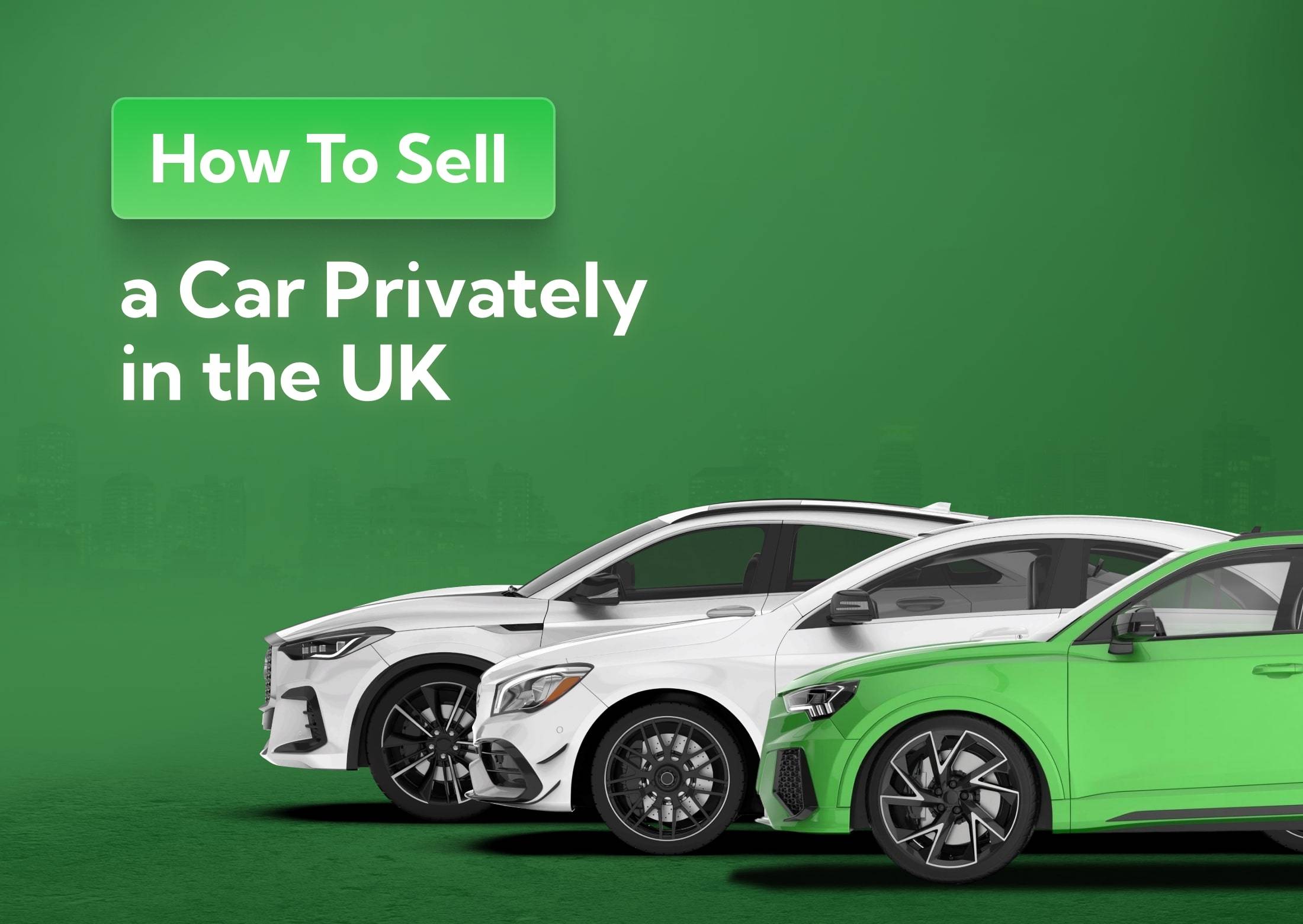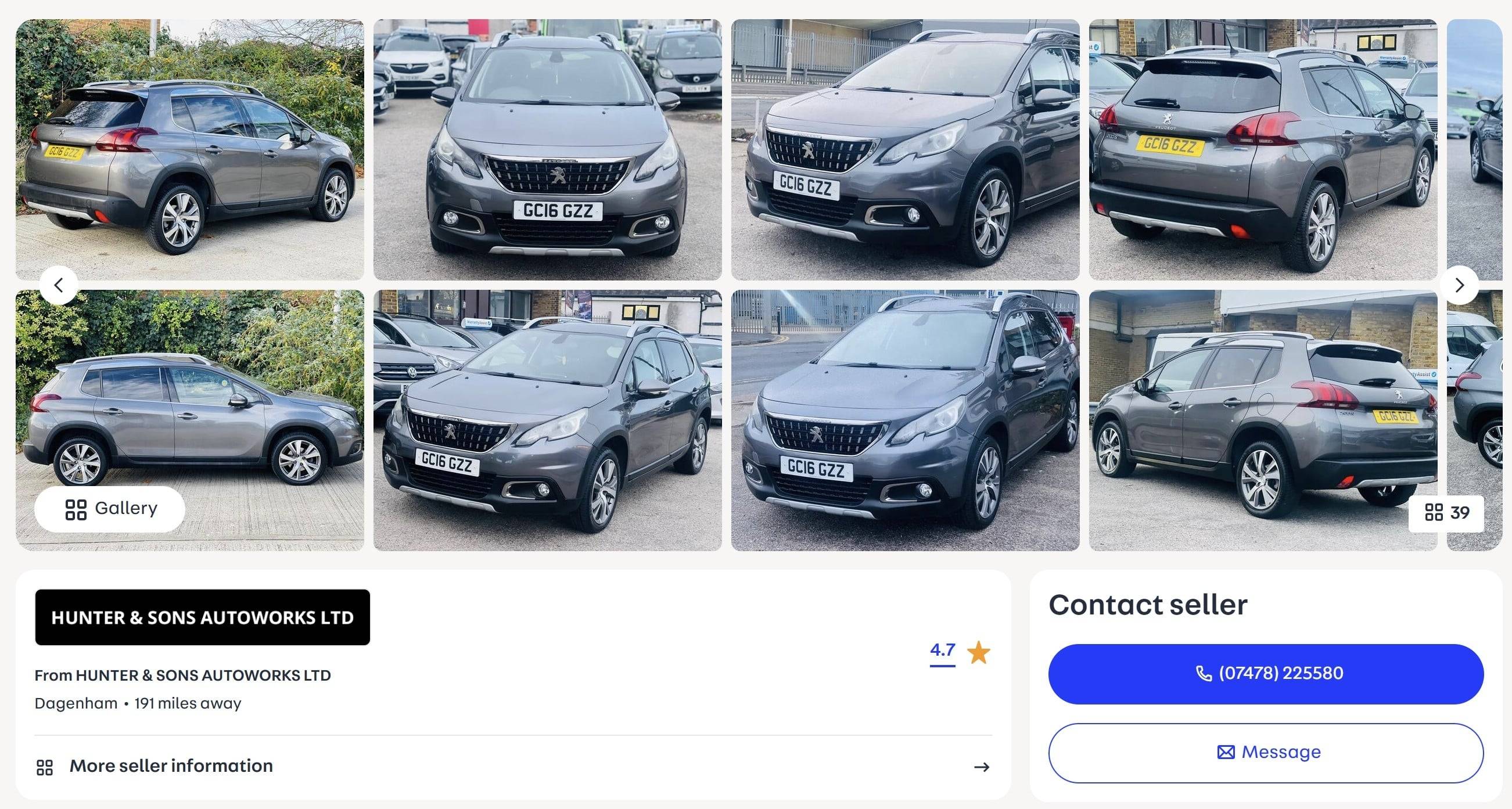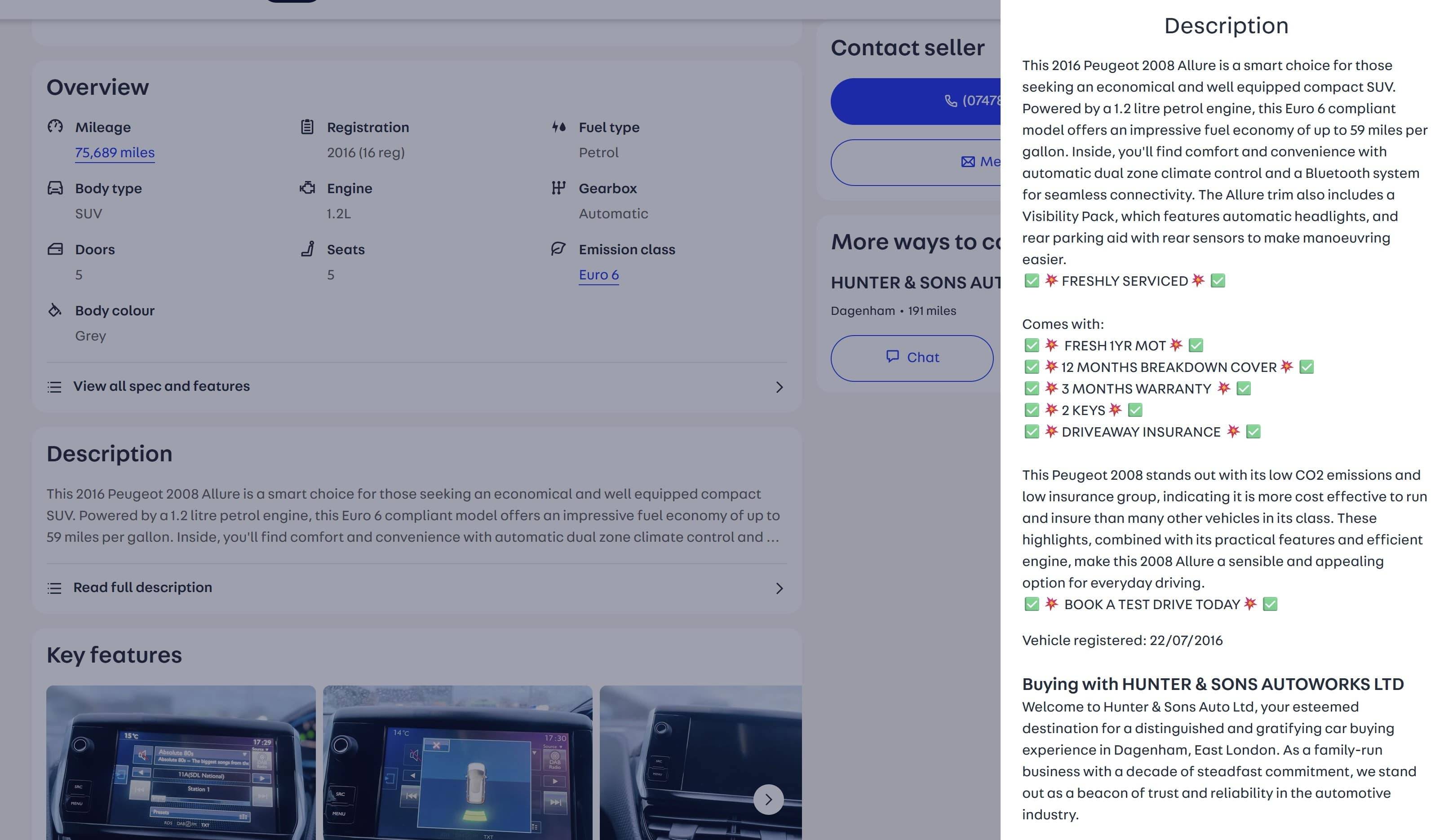How to Sell a Car Privately in the UK [2025]
Selling your car privately can earn you more money as long as you know how to do it properly. If you’re trying to sell your car on the private market safely and effectively, this guide has everything you need to know.
Last updated: 27th November, 2025

Award-winning CEO driving growth and social impact across automotive, recycling, and technology-led enterprise platforms.

Listen to this story
To sell your car privately, you have to get the documents ready, prep the car, set the price, list it, meet and negotiate with buyers, then secure payment without anyone to help you through the process.
If you want to get the absolute most money from selling your car, it’s the best way to go. But it’s a balancing act: of course you want the most money, but you’re also looking for a relatively quick and painless sale.
I’ve worked in the motor trade for decades and the truth is this: how well a private sale goes comes down to your awareness. You need to know the risks (scams and setups). And you also need to understand the reward. Higher selling price and full control of the process are only achievable if you’re informed enough to price the car sensibly and negotiate confidently.
This guide walks you through the entire process of selling your car privately in the UK, from the preliminary setup work through listing and negotiation, and finally what you have to get squared away after you transfer the car to its new owner.
What's in this article
What you need to know before selling your car
Compared with selling or part-exchanging at a dealer, going the private route comes with more challenges. For one, you’ll have to think about your own safety because criminals use private selling platforms to set up and scam people. You’re also on your own when it comes to setting a fair price, making sure the car is described accurately and staying on the right side of UK law.
That’s why you need three things locked in before you even think about listing the car: a clear reason for selling it, an accurate idea of what it’s worth and the correct documents to complete the sale legally.
Reasons for selling your car
There are a handful of common reasons you might want to sell your car:
- Upgrading to something newer
- Increasing running costs
- Dropping quickly in value
- Using too infrequently to justify the expense
- Changes in personal circumstances
The advantage of selling privately is simple: you’re in control of the price. You’re not negotiating against a dealer’s margins or convenience offers. That alone puts a meaningful amount of extra money in your pocket if you do it properly.
Determining the market value of your car
You can do this using an online car valuation tool. Just pop in your reg and it’ll give you an estimate based on current market dynamics. This is the best starting point.
Key factors that influence your car’s value include:
- Age and mileage
- MOT status and service history
- Condition inside and out
- Number of previous owners
- Any existing faults or warning lights
- Specification, optional extras and overall desirability
- Local demand for your specific make and model
- Colour and body style
- Whether you’re selling a modified car
Where your car sits in the current used market also plays a big role. YoY prices have gone up overall, but that’s not true for every car. Let’s say you own an older EV. Demand is higher with the upcoming 2030 ban, right? Well, supply also is. And EV tech is rapidly improving. Those factors have pushed used EV prices down while they’ve done the exact opposite for petrol's.
Our site has a free car valuation calculator. What makes it genuinely reliable is the data behind it. We’re one of the only UK companies with valuation inputs pulled from scrap car buyers, motor traders and garage networks, which we aggregate through our sister brands. So you get a figure that reflects the real market, not a guess.
What the experts say

Steven Jackson OBE
Required documents for a legal sale
You’ll need the following documents to complete a private sale legally in the UK:
- V5C logbook (with the correct sections filled in for a private sale)
- MOT certificate (physical copy not needed, but make sure it’s valid and up to date)
- Service history (stamped book, digital history and receipts)
- Repair and maintenance invoices
- Owner’s manual and spare keys
- Proof of address/ID (smart buyers match this with the logbook at the point of sale)
The V5C is the most important one because it’s what officially transfers the vehicle to its new keeper. You’ll give them the green ‘new keeper’ slip and notify the DVLA once you’ve sold it. If you don’t do this, you’ll still be held legally responsible for the car and you’ll be hit with up to a £1,000 fine for failing to do so.
What are the steps to sell a car privately in the UK?
Every private seller goes through seven steps when they part ways with their vehicle:
- Prep the car for sale
- List and advertise it
- Arrange viewings with buyers
- Offer a test drive
- Negotiate the final price
- Finalise the sale
- Get paid securely
Now, let’s walk through everything you need to know about each of them.
1. Prepare your car for sale.
A well-presented car sells faster and for more money; that’s just how buyers work
Before you even think about listing it, get your car ready for sale by giving it a proper clean inside and out. Hoovers, wipes, glass cleaner, the whole lot. If something looks grubby or neglected, buyers naturally assume the same about the mechanical side, even if the car’s mechanically sound.
Then fix the small, cheap things:
- Blown bulbs
- Low tyre pressure
- Worn wiper blades
- Oil and fluid levels
- Easy cosmetic touch-ups
- Warning lights on the dash (if the fix is something easy like replacing the spark plugs)
Preparing your car for sale doesn’t cost much, but it tells people the car’s been cared for. Don’t bother fixing anything that costs more than £150 to £200, though. At that point, the nominal value increase isn’t worth what you’re spending in time and labour costs.
2. Advertise your car.
Where you list the car matters more than most people think.
- Autotrader is still the strongest place to start because people who use it generally know what they want, have the cash ready and will actually turn up, plus they have buyer protections.
- eBay Motors is another solid option if you want to pull a wider range of buyers, including those looking for specific trims or fixer-uppers.
- Gumtree and Facebook Marketplace work, but they’re free to use and completely open to the public, so you’ll have to weed out the tyre-kickers, time-wasters, scammers and criminals. For the same reason, don’t rely on them to bring in the best money.
A great listing is the other half of the battle.
For photos, shoot the car in daylight, ideally on a clear day with a clean background. Get wide shots of each side, close-ups of wheels, interior, dashboard, infotainment, paperwork, standout features and any damage. Avoid overly edited photos.

As for writing the advert, keep it honest and mention everything. Mileage, MOT date, service history, ownership, condition, recent maintenance, extras, damage and write-off history are the most important ones to cover. Include why you’re selling it and what makes it a good buy.

3. Handle buyer viewings.
This is where things can go south. All over the UK, criminals try everything from payment scams to outright theft and robbery. Always schedule viewings in safe, well-lit, public locations like retail parks, supermarket car parks or outside your home if you’re in a more crowded area.
And during the viewing, set clear expectations. You’ll…
- Show them around the car
- Open everything up
- Let them inspect the paperwork
- Answer questions
- Check their ID and verify their address
That last point is the most important one not to miss. Make sure the buyer’s driving licence matches the name and details on their online profile. If they can’t produce this or the details don’t match, there’s a chance they’re pretending to be someone they’re not.
4. Offer a test drive.
Before anyone gets behind the wheel, verify they’re insured to drive your car, either through their own fully comp policy with DOC (Drive Other Cars) cover or a temporary insurance policy they’ve arranged. In addition to the licence, this shields you from liability if something goes wrong on the road and it stops uninsured drivers from taking unnecessary risks with your car.
When it comes to directing the test drive, buyers don’t mind guidance but they do mind micromanagement. What they really need is a route that lets them judge the car properly. So once you’ve confirmed they’re legit, make sure the test drive includes:
- A cold start (buyers want to hear how it idles before it’s warmed up).
- Low-speed manoeuvring, like turning into a side street or navigating a car park, to show the car’s steering and suspension capacity.
- A short stretch of faster road, even just a mile, because it lets them feel the gearbox, stability and engine pull.
- A couple of smooth stops and starts, so they can check the brakes, clutch bite and general responsiveness.
Set those expectations up front: “I’ll guide the route just so you get a fair feel for different speeds.” And make sure you come along with them, keeping the keys in your hand until you’re both seated.
5. Negotiate the price.
Negotiation is kind of intimidating because you don’t know the buyer’s skill level, but most private buyers aren’t experts either. So if your price is well-researched, the conversation is usually straightforward.
Start with a competitive asking price by checking a valuation tool and comparing what similar cars are actually selling for on Autotrader. List yours a few hundred pounds above the minimum you’d accept so you’ve got room to move without feeling squeezed.
When buyers make an offer, stay calm and keep it simple. If it’s reasonable, counter with something closer to your target and highlight its condition, history, recent work, spec or whatever value point you can.
Lowball offers might happen, to which you’ll just decline politely: “Thanks, but I’m not going that low.” If you’re firm on the price, a serious buyer will come back with a fair number. Or, if they won’t but you know the car’s worth more, you can hold out for a better offer.
6. Finalise the sale.
Once you’ve agreed on a price, the rest is mostly admin. Still, it’s it’s important you do it properly.
Start by filling out the V5C together. They’ll enter their details on the green ‘new keeper’ slip (Section 6 on new-style logbooks; Section 10 on old-style ones). They’ll need this to insure the car, tax it and drive it away. You’ll need it to tell the DVLA, which you’ll also do at the point of sale (more on this in a bit).
Then, write up a simple receipt with:
- The car’s details
- Sale price
- Statement that the car was “sold as seen”
- Date and both of your names and signatures
Nothing fancy, but you need proof the transaction happened in case something goes wrong later.
7. Choose a secure payment method.
When you accept payment for the car, you have a couple options:
- Bank transfer (Faster Payments): The safest and most common option. Funds usually arrive within minutes and you can confirm the money’s in your account before handing over the keys. Only thing to remember is that some banks have transfer limits, so the buyer may need to make two payments or call their bank.
- Cash (at a bank branch): This also gives you the benefit of immediacy, and there are no transfer issues. But counting cash in a random car park is risky because of counterfeit notes, robbery and disputes. If you’re accepting cash, do it inside a bank so staff can count and verify the notes on the spot.
Bank drafts and cashier’s cheques look like a secure option on paper, but you should never use them because drafts are easily forged and banks don’t always confirm authenticity right away. You could hand over the car and later find out the draft was fake.
PayPal is also not a good option. Scammers use it all the time because motor vehicles are excluded from PayPal's Purchase Protection program.
What to do after selling your car
Once you sell the car, you’ll close off all the loose ends on your side. That starts with notifying the DVLA. Then, you’ll cancel your insurance and get your remaining months of road tax back.
Notify the DVLA.
Like I mentioned earlier, you’ll actually do this at the same time as you sell the car, with the buyer in front of you. When you complete the V5C transfer online through the official GOV.UK service, the DVLA updates the keeper record immediately.
- You enter the 11-digit reference number from the V5C.
- You submit the buyer’s details.
- The DVLA system confirms the change right away.
- You (the seller) get an instant confirmation email.
Then, you hand the buyer the green V5C/2 slip. They tax and insure the car online right there and then, and drive away legally.
If you don’t do it this way, the DVLA has no way of knowing you’ve sold the car. As far as they know, you’re still the one who’s legally responsible for it. So you’re on the hook for tax, fines, parking tickets, congestion charges and anything the new owner does with the car. Plus, they won’t be able to register the car.
Cancel your car insurance.
Cancel your insurance as soon as you sell the car. Until you do, the policy is still active in your name, which means you’re technically insuring a car you no longer own.
- Contact your insurer to cancel your policy.
- Give them the date and time the vehicle was sold.
- Confirm the DVLA transfer has been submitted.
- Ask for a refund of the unused premium (some monthly policies allow this).
- Cancel the add-ons tied to the policy, such as breakdown cover.
If you’re replacing your old car with a new one right away and you’re happy with the policy, the alternative is to call your insurer and update the policy with the new vehicle’s details. They’ll adjust the premium, send updated documents and the cover switches over instantly.
Cancel road tax.
This is the easiest part. As soon as you notify the DVLA of the sale, your road tax is automatically cancelled, and they refund any full remaining months directly to you.
- Complete the V5C keeper change online at the point of sale.
- DVLA automatically cancels the tax on your side.
- A cheque is posted to the address on your V5C for any full unused months.
When the DVLA registers the change of keeper, they stop taxing the vehicle under your name and calculate the refund based on full months remaining (i.e. excluding the current month, which is already partially through its course).
And one more thing to remember about road tax when selling your car: the tax never transfers. The new owner taxes the car themselves before driving it.
Keeping records of the sale
It’s important to keep a copy of the sale receipt and related documents because they’re your proof of when the vehicle changed hands. If fines, penalties or disputes arise post-sale, those records show clearly that the car was no longer your responsibility.
Keep the receipt, DVLA confirmation email, copies of the V5C details you submitted and all the messages and agreements with the buyer for at least 12 months. Some people keep them longer, but a year comfortably covers legal and administrative issues that could potentially stem from this.
Store everything somewhere easy to retrieve. A scanned digital copy in your email or cloud storage works well and makes future reference painless.
Completing the V5C logbook
To finalise the sale properly, you’ll need to complete the green ‘new keeper’ of the V5C with the buyer. The information you’ll fill in includes:
- The buyer’s full name
- Their address
- The date of sale
- The mileage (optional but encouraged)
- The vehicle details (already printed on the form)
Before you submit anything, make sure the buyer’s details are legitimate. Get their driving licence so you can confirm their name and address match what they’re giving you.
Once that’s done, you hand the buyer the green V5C/2 new keeper slip, which they’ll use immediately to tax and insure the car before driving it away. The DVLA then posts them a brand-new V5C within two weeks, officially confirming them as the new registered keeper.
Provide documents to the buyer
Alongside the V5C, you should hand over anything that proves how well the car’s been looked after. That means the service history book, printed records and/or a digital history from the manufacturer. Also include receipts for recent repair work – especially things like tyres, brakes, timing belt changes and major servicing.
These documents show the car’s been maintained properly and help the buyer understand what’s already been done and what won’t need doing again any time soon. So they matter because they help the new keeper get the most life out of it.
They’re going to want this info if they ever go on to sell the car. Just like they looked into the car’s history, future buyers will, too.
How to sell your car safely and quickly
It goes without saying you want to sell the car as quickly as possible. But you never want to do so at the expense of your safety. You have to balance the two.
Sell your car safely
To sell your car safely, take the following precautions:
- Verify the buyer’s identity. Ask to see a driving licence before a viewing or test drive. Match this with the name and info on their online profile and insurance policy (which you’ll use to check they can drive your car) so you know they’re not a fraudster. Note: A passport is also a valid ID, but it’s not what they’ll use for driving so it’s irrelevant here.
- Meet in a safe location. The most important aspect of selling your car safely. Choose well-lit, public places like supermarket car parks and retail parks. Avoid isolated areas and late-night meetups because that’s where it’s easy for criminals to act without getting caught. Explain that this is for your safety and theirs.
- Protect your personal information. When you sell a car privately, there’s no need to give out your full address, insurance details or anything tied to your financial information. And when showing documents like service records, cover sensitive personal details like your home address if they appear on old invoices.
- Secure payment before completing the sale. Most car selling scams rely on one of two things: uncleared funds or reversible payments. That’s why you should never hand over the keys until the money is in your account and fully cleared, and never accept cheques, bank drafts or PayPal transfers.
- Document the sale. Buyers might try to claim they never received paperwork, insist details were “agreed differently” or come back weeks later saying the car had faults you supposedly hid. A proper receipt and transfer of ownership shuts all of that down instantly. Store it in a safe place in your home for at least a year after selling.
Sell your car quickly
Now for the other half of the battle. To sell your car as fast as possible, do the following:
- Price your car competitively. Speed comes from pricing it realistically. Use our valuation tool, check similar cars that are actually selling, then set your price to sit comfortably within that range. A fair, well-researched price gets attention immediately.
- List on multiple platforms. More visibility = more enquiries = faster offers and more leverage. Start with Autotrader because paid platforms attract serious buyers, but add eBay Motors, Gumtree and FB Marketplace to cast a wider net. Follow the same listing rules for each and use their built-in prompts to add your vehicle info and specs.
- Sell to a dealer or car-buying service. If time matters more than money, dealers and instant car-buying services buy the car same-day with minimal hassle. You won’t get private-sale prices, but you’ll get speed and certainty. To maximize your return, use well-reviewed services with guaranteed same-day offers.
- Use online auctions for a quick sale. There aren’t many open to the public. But sites like eBay, Trader.co.uk,RAW2K, and certain Manheim auctions quickly put your car in front of several buyers at once. They’re great especially if you’re selling a written-off car. You submit the details, the car goes into a timed auction and you get a guaranteed offer at the end.
Frequently asked questions
Yes, you can legally sell your car without an MOT, but expect fewer interested buyers and a lower price. The buyer can’t legally drive it away unless it’s to a pre-booked MOT test, which is inconvenient and gives them easy leverage to push the price down. Not to mention, most buyers assume “no MOT” means “hidden issues” even if that’s not the case.
If the buyer doesn’t transfer the V5C on their end, it doesn’t affect you as long as you handle the handover and DVLA notification on your side. Once you’ve submitted it to the DVLA and you get confirmation of that, you’re no longer responsible for the vehicle. If the buyer forgets to tax or update their details, that’s on them.
However, if you are the one who fails to transfer the V5C, that’s where problems start. Fines, penalties and liability stay tied to your name in this scenario.
You cannot sell a car with outstanding finance. Until the finance is settled, the car is legally owned by the finance company, not you. You must clear the finance first (or arrange a settlement directly with the lender) before you can sell it.
The best time to sell your car is whenever you’re genuinely ready to move it on. Waiting for a tiny price bump that may never materialise costs you more in insurance, tax and depreciation. A clean, well-priced car sells well in any season.
As a private seller, you’re not legally required to provide a warranty. The car is sold “as seen”, so as long as you’re honest about its condition and don’t misrepresent anything, you’re good to go.
About Car.co.uk

Share on
Latest news & blogs










